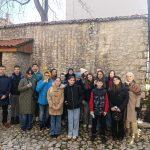The Archaeological Collection was established alongside the founding of the Museum of Sarajevo in 1949. Nowadays, the collection comprises approximately 3,000 items, which collectively to a certain degree reconstruct the past of the Sarajevo region from the Neolithic period through to the Ottoman era.
The collection comprises materials from three primary eras:
- Prehistory
- Roman times
- Middle Ages
Objects in the Museum of Sarajevo collection showcase the evolution of material choices for creating utility items, tools, weapons, and jewelry from the Early Stone Age to the Middle Ages. While ceramics, bone, and horn were used across all periods, the use of metal began in the Copper Age, and glass objects appeared from the Late Iron Age through Antiquity and the Middle Ages.
The prehistoric segment of the collection features material from the Neolithic period up to the early years of Roman rule in Bosnia and Herzegovina. The Neolithic artifacts are primarily from the Butmir settlement, known for its characteristic ceramics and figurines (the distinctive ceramics and plastic). Butmir, discovered in 1893, is the oldest and most renowned archaeological site in Bosnia, and an entire cultural group of the younger Neolithic of central Bosnia was named "Butmir culture" after it. This Neolithic settlement was built on the loess elevation of the Pleistocene terrace of the Željeznica River, near present-day Butmir. The site's stratigraphy includes lower layers belonging to the Kakanj culture, followed by Butmir I and II, and the uppermost Hvar-Lisičići culture layer represents the final phase of younger Neolithics. On the bases of the absolute chronology it is believed that life in this settlement is to have spanned from 5500 to 4500 BCE. The fertility cult, the most significant aspect and manifestation of Neolithic agricultural cultures worldwide, at Butmir is evidenced by the figural plastics with prevailing female figurines, and decorative motifs on ceramic vessels found at Butmir site. During the classical Butmir culture (Butmir II), a distinctive artistic style emerged, particularly in ceramic vessel decoration, with spiral and strip ornamentation and fine arts high-quality figurines. The metal age artifacts primarily come from two hillforts, Debelo Brdo and Ilinjača, and the collection items from this phase include examples of jewelry such as fibulae, pendants, belts, decorative pins, and buttons.
The ancient portion of the collection archaeological material originate from the area of the former Roman settlement Aquae S. and the settlements in Kotorac, Debelo Brdo and Stup. This segment features mosaics, ceramics, metal tools and weapons, copper dishes, tombstones, and altars. Analysis of Roman inscriptions indicates that Aquae S. had an autonomous city administration, as a settlement unit it did not develop spontaneously and organically over a long period of time, and was most likely established through planned Roman authorities activity, possibly under Emperor Marcus Aurelius (161-180 AD), who, in the second half of the 2.century settled retired Roman soldiers and veterans in the area of Sarajevo Polje. The settlement received the full status of a colony of Roman citizens through the formal act of establishing the colony (M. H. Ćeman, 2000, 134). By the decree of the Constitutio Antoniniana in 212, all autonomous tribal communities and their associated settlements became municipal territorial-political communities. This decree advocates the status of a colony to a clearly profiled settlement, thus Aquae S. settlement .becomes a significant and stable point of Roman presence.
The medieval section of the collection spans the 7th to the 15th centuries and contains objects from the period of the early, developed and late Middle Ages It includes silver fibulae, earrings, necklaces, silver and gold-plated buttons, rings, cold weapons, and stećaks (medieval tombstones). These items were mostly collected through archaeological research from the mid-20th century to the present, with some acquired through purchases or donations. Part of this collection is displayed in the permanent exhibition at the Brusa Bezistan department of the Museum.
The rich inventory of mobile archaeological materials and documentation from key sites in and around Sarajevo has made this collection a cornerstone for studying the prehistoric, ancient, and medieval cultures of Bosnia and Herzegovina. Researches based on this collection, that had existed for several decades now, has been published in over two hundred articles, studies, and monographs, significantly advancing the field of archaeology and securing Bosnia and Herzegovina an important place on the archaeological map of Europe and the world. The collection also includes a conservation laboratory dedicated to maintaining the condition of these artifacts.
Archaeological materials are acquired through citizen donations, purchases, and primarily through fieldwork, including reconnaissance, archaeological surveillance, and various types of archaeological research. This ongoing effort helps create a comprehensive archaeological picture of Sarajevo and its surroundings within the broader context of Bosnia and Herzegovina and Europe.
- Collection Manager: Adnan Muftarević, Museum Councilor, archaeologist
- Origin: archaeological research, purchase, gift
- Type of objects: ceramic dishes, figurines, oil lamps, glass objects, parts of costumes, jewelry, household objects, tools, weapons and military equipment, equestrian equipment, metal objects for construction purposes, architectural plastics, stone monuments



